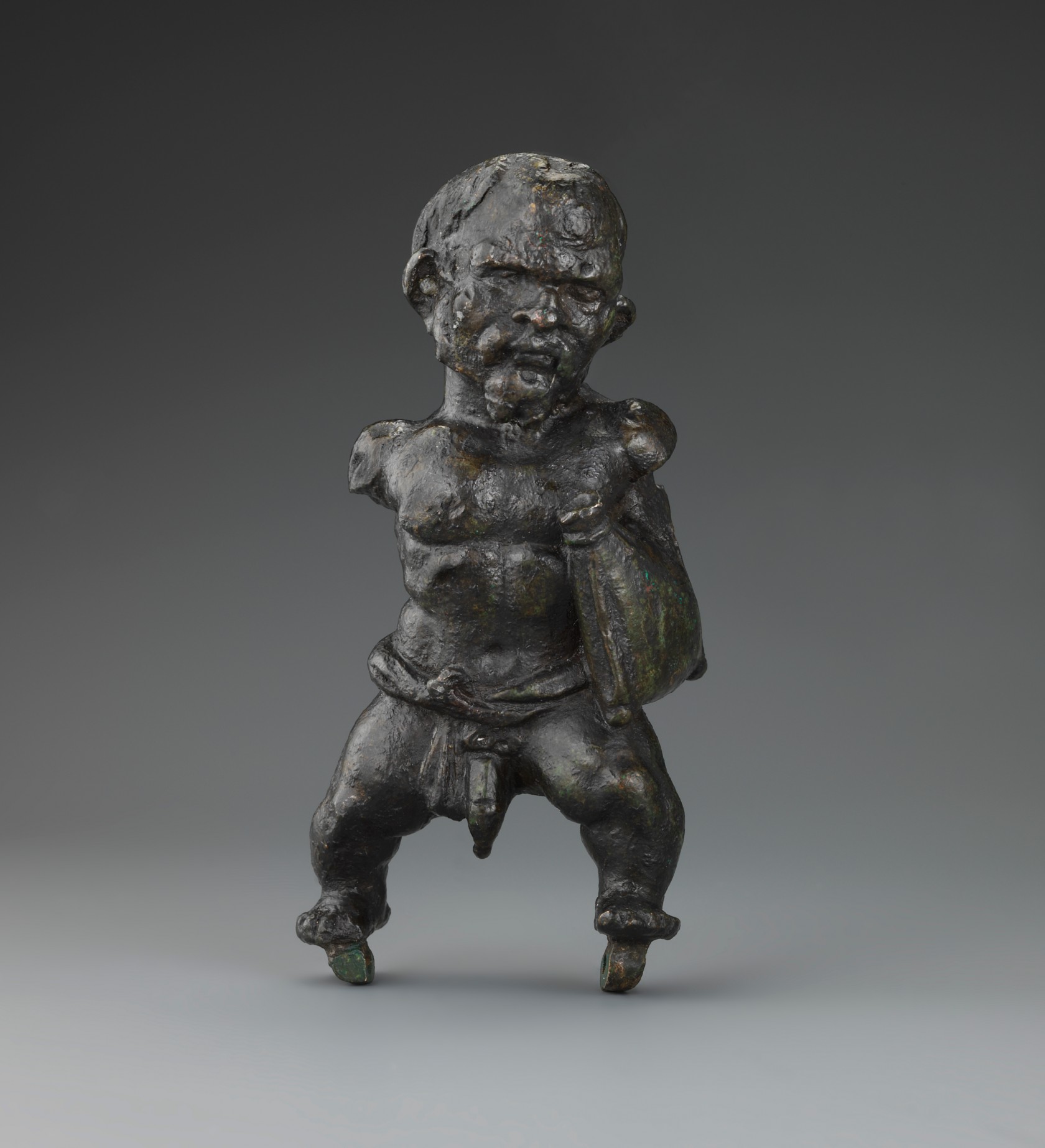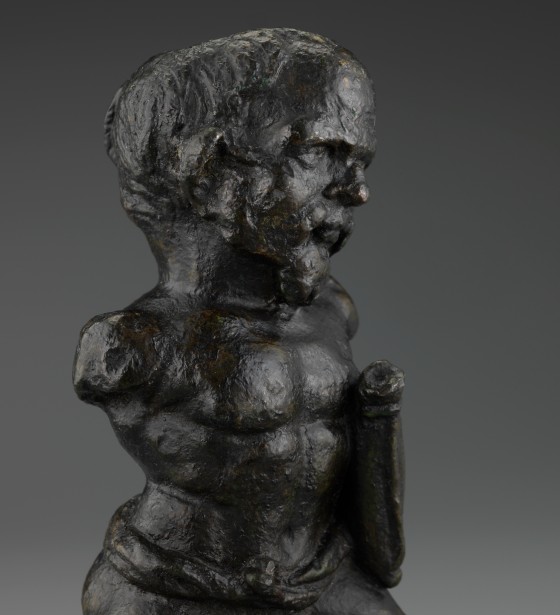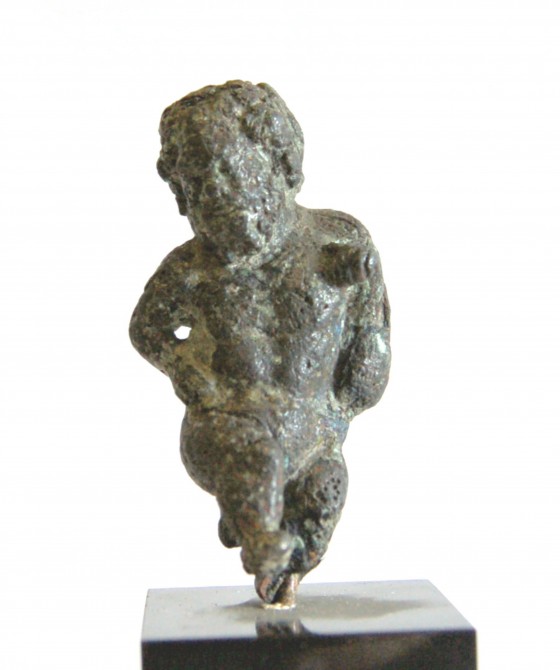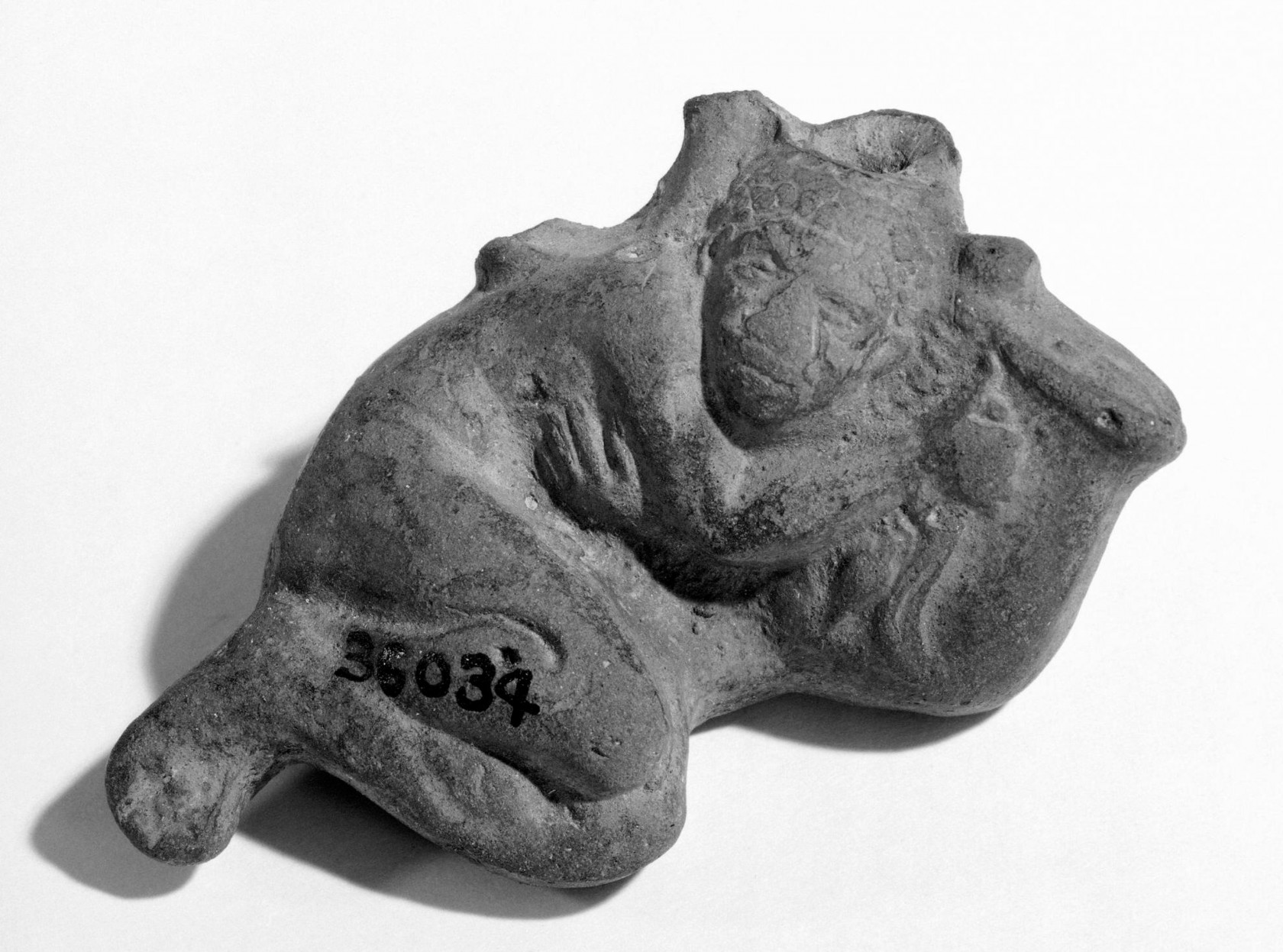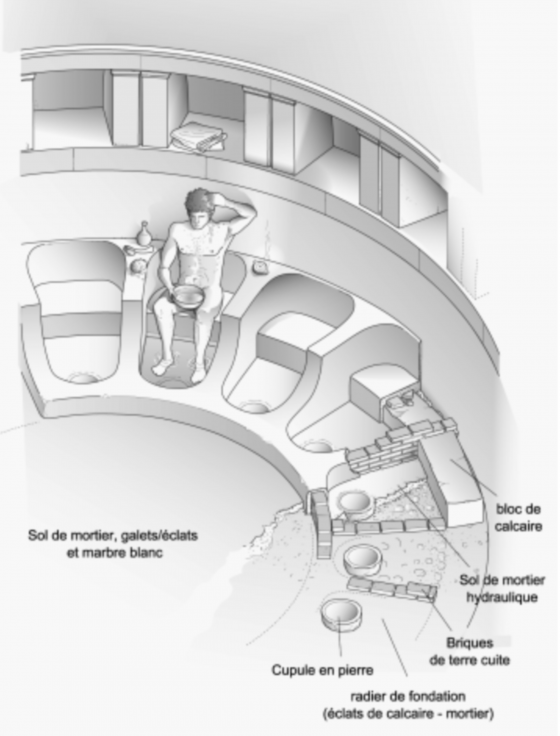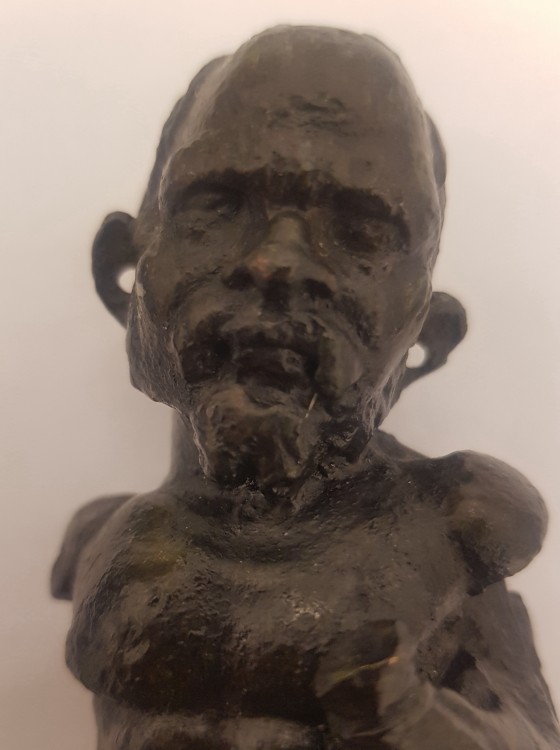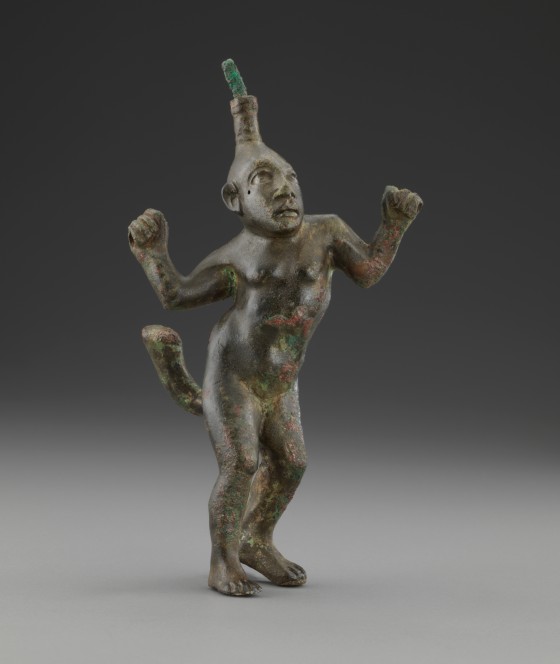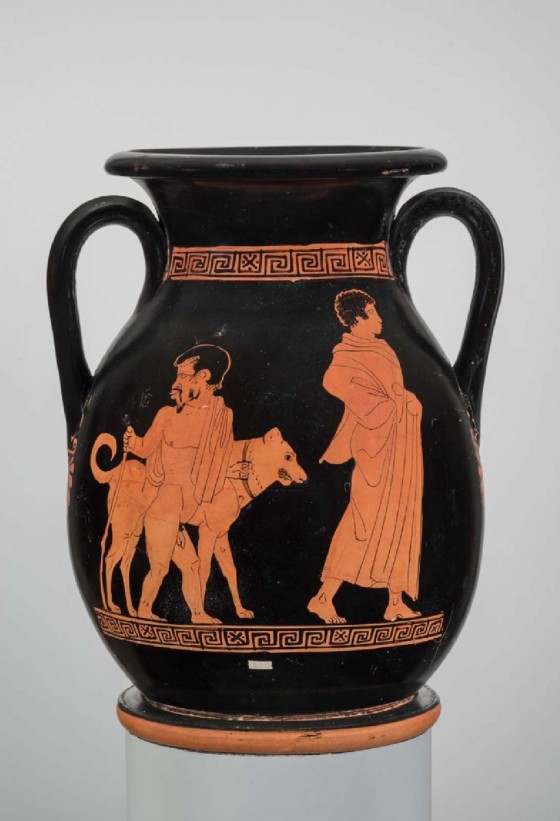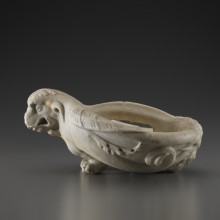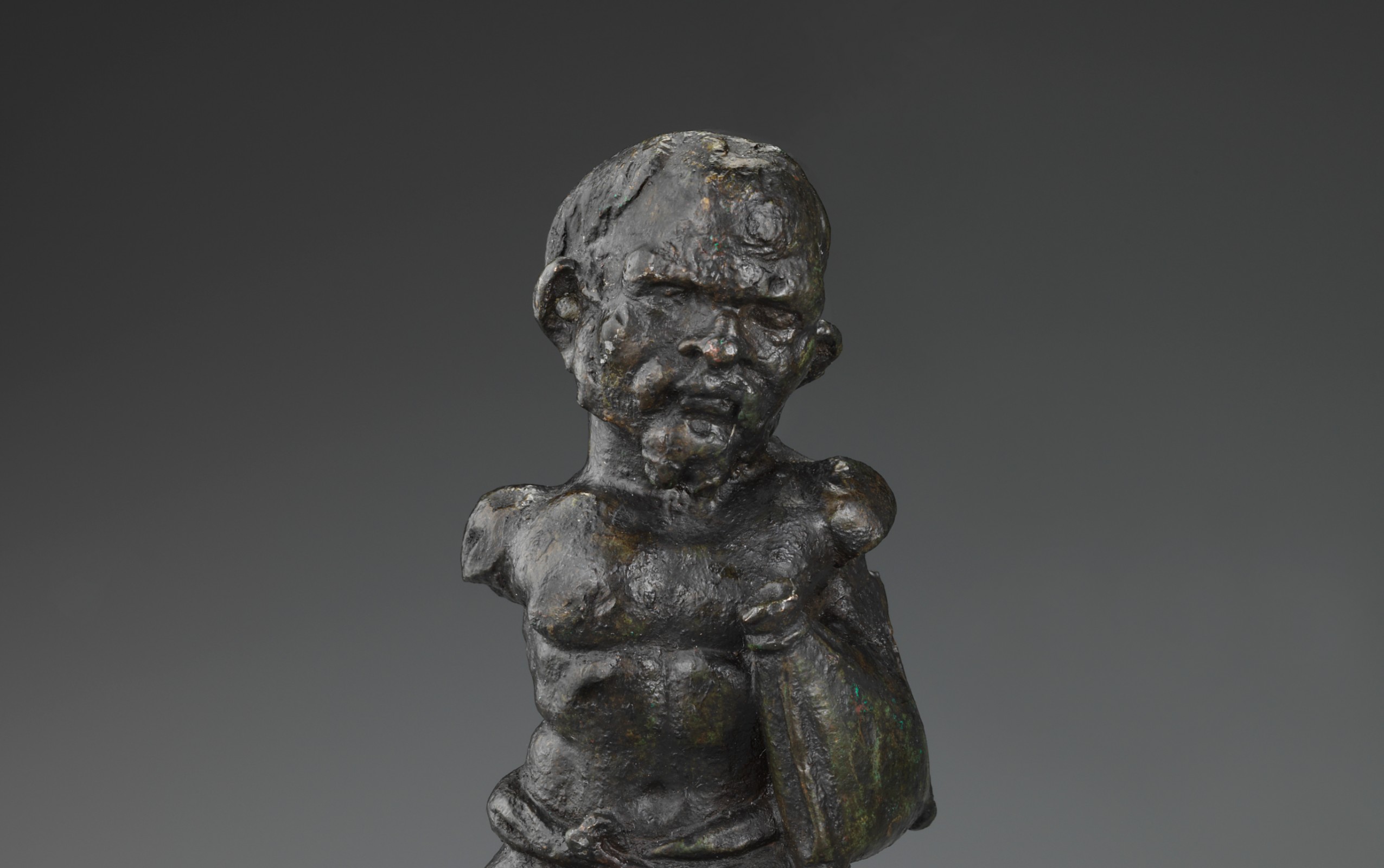
November 2023 Archaeology
Laughter as a weapon against
the evil eye
This statuette of a dwarf slave, which passed from one collector to the next since the 19th century, has more than one story to tell, whether we consider the point of view of the Game of Thrones fan who would somehow bump into the present “Artwork of the month”, of the amateur of beautiful objects, or of the rich Roman who was its very first owner. Let’s dive into the world of slaves and baths…
See the artwork in the collectionStatuette of utrarius dwarf
Egypt (Alexandria), late 1st century BC – early 1st century AD.
Bronze
9.8 x 5.3 x 3.5 cm
FGA-ARCH-GR-0048
Provenance
Collection B., Briançon
Collection Dufrène, Metz (mentioned in the Charles Cournault album, II, 70)
Collection Victor, Münster, inheritance
Gordian Weber Kunsthandel, Cologne
Acquired on 05.10.2010
A first draft for Tyrion Lannister?
A connoisseur of TV series might regard this small bronze figure as an early version of Tyrion, the cunning Imp of House Lannister, one of the most striking characters in the Game of Thrones saga1. Like him, our little bronze man suffers from achondroplasia, a form of dwarfism characterized by a disproportionate head compared to the size of the body, a dolichocephaly underlined by a bulging forehead and strong occipital protrusion, and short limbs (fig. 1)2. The developed muscles of the torso and limbs, well formed but crooked, give Tyrion and his antique cousin a radiant physical presence, which is also due to the expression of their face and their energy.
The eye of the collector
A little man from Alexandria
The collector fond of deliciae will appreciate the quality of this statuette, its realism and its fiendish attention to detail. The face is that of a middle-aged man, tired and without beauty, but touching by its realistic traits. His tired eyes, underlined with bags, betray anxiety. A thick and falling moustache, as well as an untrimmed beard, hide the lower part of his face (fig. 2). Both arms are broken off at the shoulder, but the left one was clutching his burden. His attributes – a goatskin and a thin fabric around the waist – also tell us about his current occupation: this is a waterskin-carrier (Latin: utrarius), and his nearly complete nudity suggests that he was employed either in public or private baths – such as the house of a wealthy man of Alexandria enjoying his own hot baths. With his limping gait, he looks somewhat pathetic, unlike the proud Tyrion Lannister.
Judging from its realistic features, this piece can be dated to the end of the Hellenistic period: its touching details make it a good example of the Alexandrian taste of the late Ptolemaic or early Roman period (1st century BC – 1st century AD). Two other small slaves, a dwarf similar to the one in the Fondation (fig. 3) and a young African sleeping on his empty waterskin (fig. 4), are inspired by similar themes3. Slaves, short-sized persons, elderly fishermen and old drunk women were as many trendy subjects in the workshops of Alexandria, which were also appreciated in Rome. Slaves were nearly always depicted as idlers or as thieves and, if shown at work, most often bowing. “Never is slavery straight of head, but ever crooked and keepeth her neck askew”, according to the 6th century BC poet Theognis of Megara4.
The dangers of hot water
The waterskin hanging from his shoulder by a strap is a masterpiece of realism, which will thrill both the collector and the archaeologist. Almost parallelepipedic, probably cut in the hide of a goat, it was sewn, as shown by the side stitchings. So as to warrant an even flow of the liquid, its opening was hardened with a terracotta pipe, like those described by Varro5, and sealed with a wooden stopper. This small waterskin was used to carry hot water for a bath, as the animal hide enabled to keep the high temperature of the water6. A tricky task, as one had to avoid scalding the bather, or surprizing them with an unexpected temperature: a papyrus records the grievances of Philista, a woman injured by the hot water poured by a slave at the baths of Trikomia (Egypt), in this case not in a waterskin but with arytaina, a vessel used to draw water directly from the cauldrons7. Some four centuries later, at the age of twelve only, the future emperor Commodus is said to have ordered a bathkeeper to be thrown in a furnace because his water was lukewarm8. Fortunately for him, his superior “burned a sheep-skin in the furnace, in order to make him believe by the stench of the vapour that the punishment had been carried out”.
The Graeco-Egyptian balaneia
The collective baths – balaneia – of Ptolemaic and Roman Egypt, which belonged to private individuals or to the state9, were taxed by the ruling power. Their organization is therefore well-known, by contracts, private or public letters, as well as different administrative documents recorded on papyri. Excavations also enabled to uncover many “Greek-style” baths, equipped with a water heating system. Dated to the Hellenistic and Roman periods, these baths are characterized by a rotunda of small flat tubs somewhat similar to our hip baths (fig. 5, from Taposiris Magna)10. The user would sit with his feet in the water, and a bath assistant, free man or slave, would bring him hot water11. This service was charged. In the works of Theophrastus, the Shameless man, who is quite greedy, helps himself from the cauldrons of hot water, thus sparing the service of the attendant12.
A Roman look on the statuette
Between wonder, astonishment and aversion
How did a wealthy Alexandrian or Roman citizen consider this statuette? It was only a part of a larger object, perhaps a lamp, as suggested by the two rings under the feet, which enabled to fix the piece on a base, and the circular cavity on top of the skull, which might correspond to a broken tip used to fix the flammable product. Of course, this is a caricature of a slave meant to be seen by free and rich people, who also owned real slaves. Displaying this kind of object was a token of social success13.
For the Greek or Roman citizen of Alexandria or Rome, this statuette was first meant to provoke astonishment and wonder (greek thauma), and then disgust and laughter.
For the Greek or Roman citizen of Alexandria or Rome, this statuette was first meant to provoke astonishment and wonder (greek thauma), and then disgust and laughter. Wonder, because this little man is quite a marvel of nature; in Egypt, Bes and the Pataikos were dwarf gods, and as early as the 3rd millennium AD, small-sized persons were chosen to be part of the king’s entourage14. Dwarfism was a divine sign! Disgust, because this small figure displays all the features of the slave: receding, short and dishevelled hair – slaves had to be short-haired –, cirrus (the typical tuft of hair worn by slaves in Alexandria, which hangs at the back of the head), unshaved beard, muscular body shown in hard work. A slave, the visually exact opposite of a free man.
Bored ears
Moreover, his ears are pierced (fig. 6). A feature rarely seen, and without any parallel so far. This detail requires two commentaries: first, the mention of a verse of Juvenal (1st century AD), who describes a freshly emancipated man, who came from the shores of the Euphrates to Rome, and whose ears are bored15. A sign of slavery: the foreigner boasting in Rome used to be a slave in the East! Two passages of the Bible also mention a similar ritual, which was to pierce the ear of a slave with an awl “against the door” to mark the final subjugation to his master16. Apparently, the piercing of ears was a mark of slavery in the East, or of belonging to a master in a Jewish context. The free man, however, showed his status with an intact body: no holes in the ears, no whipscars, nor any other disgracing traces: the only marks which could proudly be shown were those of injuries in battle, a token of courage17.
Do not hide this sex that I could not see…
Disgust was also aroused by his conspicuous nakedness: in the eyes of the Romans, nothing was more outrageous than nudity, and especially that of the phallus18. When visible, it was all the more shocking when circumcised, as is the case here, because circumcision was loathed by the Romans19. The ideal sex had to be discreet, intact and hidden under the toga. On the contrary, slaves and dwarves were supposed to have an unbridled sexuality, encouraged by oversized-looking genitalia. However, unlike many depictions of small persons, hunchbacks or slaves, which were as many lucky charms, the sex shown here is neither turgescent nor pointing backwards (fig. 7)20. For the well-educated yet superstitious citizen of Rome or Alexandria, the effect of these images was embarrassment, followed by laughter. These depictions, which evoked a marvel of divine nature, and the long, naked, visible and flaccid phallus of the slave, while making them laugh, was a means to ward off the evil eye and to bring good fortune.
The slave dwarf, halfway between thing and pet
We shall now leave the constantly stereotypical depiction of ancient slaves to consider the sad reality of slavery. In Ptolemaic and Roman Egypt, which was one of the main sites for this market, the slaves would come from everywhere, often as prisoners of war, from sub-Saharan Africa to the Roman Orient, as well as Gaul and the Germanies21. But what is a slave in antiquity? Nothing but a res mobilis or “movable property”, something which can be bought, collected, sold, and can be whipped, marked, tattooed on the front as a symbol of ownership or of shame22. Fortunately, this did not prevent sincere friendly relationships between the owner and his “thing”, as sometimes expressed in funerary inscriptions23.
As for dwarf slaves, they would probably enjoy a slightly more enviable status: since their market value was higher than that of a usual-sized slave, they were deemed more precious. The Ancients considered them as pets, a status confirmed by a vase showing, behind a young man, a dwarf slave holding a large dog by the necklace (fig. 8)24. Under the Roman Empire, several dwarves would live close to the Emperor and his family25. They were appreciated for their natural gifts as dancers, acrobats, musicians, in short as entertainers26. But their true power was probably elsewhere: with their astonishing physical features, they would provoke laughter – a slayer of the evil eye – and would thus become perfect living talismans or charms27. A very Roman way of giving them a place in a society more inclined to cruelty than compassion.
Dr Isabelle Tassignon
Curator Archaeology Collection
Fondation Gandur pour l’Art, November 2023
Notes and references
- I thank my colleagues Adeline Lafontaine, Lucie Pfeiffer and Sylvain Rochat for sharing their thoughts on dwarves and TV-series.
- Dasen, Dwarfs, p. 8-10.
- London, British Museum, inv. 1925,0120.2 (bronze) and inv. EA36034 (terracotta ampulla).
- Theognis of Megara, Elegiac Poems, 535.
- Varro, Rerum rusticarum, I, 8, 5 (pipes called cuspides): Marlière, L’outre et le tonneau, p. 17.
- Waterskins filled with hot liquid were also used for therapeutic purposes: Hippocrates, Diseases II: 12, 14 and 16; Diogenes Laertius, Lives of Eminent Philosophers, V: 1, 16 (about Aristotle who would place “a skin of warm oil” on his stomach).
- P. Enteux. 82, dated 221 BC; Redon, “Rencontres, violences, …”, p. 68-69.
- Ælius Lampridius, Life of Commodus, I, 9.
- For these matters: Blouin, “L’État aux bains”, p. 822 sq.
- Fournet, “Heating Systems”, pass. ; Fournet, “Balaneia grecs”, pass.
- Ginouvès, Balaneutikè, p. 213.
- Theophrastus, Characters, IX, 8: “A favorite trick of his is to march up to the tubs in a private bath-house, draw a bucket of warm water, dash it over his head, despite the loud protests of the attendant, and then say, as he leaves: ‘That’s a good bath; no thanks to you!’”.
- Ballet, Jeammet, “Petite plastique”, p. 67-68.
- Dasen, “Des artistes différents ?”, p. 265-267.
- Juvenal, Satire I, 104; “Natus ad Euphratem, molles quod in aure fenestræ/Arguerint, licet que negem?”; Garrido-Horry, “Va nu-pieds et porteurs de litières”, p. 69, n. 8.
- Ex., 21, 6: “If a slave says: ‘I love my master, my wife and children, I do not want to go out free’, then his master shall bring him unto God, and to the door or door-post, and he shall pierce his ear with an awl, and the slave will serve him forever.” See also Deut., 15, 17.
- Cordier, “Remarques sur les inscriptions corporelles”, p. 190.
- Cordier, Nudités, p. 251 sq.
- Cordier, Nudités, p. 259 sq.; Masséglia, Body Language, p. 288. On circumcision: cf. Martial, Epigrams, VII, 55, 6-8; Cordier, “Les Romains et la circoncision”, pass.
- Ballet, Jeammet, “Petite plastique”, p. 48-50.
- Straus, L’achat et la vente, p. 280-281.
- DuBois, Slaves, p. 103-104; Joshel, Slavery, p. 38; Joshel, Hackworth Petersen, The Material Life, p. 237 and n. 27. For two bronze depictions of slaves with tattoos: Franken, “Sklavenschicksale”, p. 143-145, fig. 9 and 10.
- Zaccaria, “Fidelissimus Servus”, p. 198-199.
- Boston, Museum of Fine Arts, inv. 76.45, ca. 440 BC, see https://collections.mfa.org/download/153831; Girardot, “Cherchez l’esclave ! …”, p. 411.
- Trentin, “Deformity”, pass. See Pliny, Natural History, VII, 16: “In the reign of the same emperor [Augustus], there was a man also, remarkable for his extremely diminutive stature, being only two feet and a palm in height … he was a great pet with Julia, the grand-daughter of Augustus. There was a female also, of the same size, Andromeda by name, a freed-woman of Julia Augusta.” Suetonius, Lives. Augustus, 43, 9, about the dwarf Lucius who would perform during imperial shows, under Augustus.
- Husquin, L’intégrité du corps, p. 83-86.
- Dasen, “Des artistes différents ?”, p. 271-272; Husquin, L’intégrité du corps, p. 115-118; Masséglia, Body Language, p. 295-297.
Bibliography
Ballet, Pascale, Jeammet, Violaine, “Petite plastique, grands maux. Les ‘Grotesques’ en Méditerranée aux époques hellénistique et romaine”, in Bodiou, Lydie, Mehl, Véronique, Soria, Myriam (eds), Corps outragés, corps ravagés de l’Antiquité au Moyen Âge, Turnhout, Brepols, 2011, p. 39-82.
Blouin, Katherine, “L’État aux bains. Terminologie fiscale et gestion étatique des bains collectifs dans l’Égypte hellénistique et romaine d’après la documentation papyrologique grecque”, in Boussac et al., 25 siècles de bain collectif en Orient, 3, p. 821-834.
Boussac, Marie-Françoise, Denoix, Sylvie, Fournet, Thibaud, Redon, Bérangère (éds), 25 siècles de bain collectif en Orient. Proche-Orient, Égypte et péninsule Arabique. Actes du 3ème colloque international Balnéorient organisé par l’Institut français du Proche-Orient et la Direction Générale des Antiquités et des Musées de Syrie, Damas, Syrie, 2-6 novembre 2009, Cairo, Institut français d’archéologie orientale, 2014 (Études urbaines, 9.4).
Chapot, Victor, “Uter”, in Daremberg, Charles, Saglio, Edmond, Pottier, Edmond, Dictionnaire des antiquités grecques et romaines, Paris, 1871, p. 613-616 (online: https://dagr.univ-tlse2.fr/consulter/3031/UTRARIUS/page_622).
Cordier, Pierre, “Les Romains et la circoncision”, Revue des études juives, 160, 2001, p. 337-355.
Cordier, Pierre, “Remarques sur les inscriptions corporelles dans le monde romain : du signe d’identification (notitia) à la marque d’identité (identitas)”, in L’objet dans l’image II. Journée d’étude organisée par le CRATA-GRACO dans le cadre du DEA Sciences de l’Antiquité, Pallas, 65, 2004, p. 189-198.
Cordier, Pierre, Nudités romaines, Paris, Les Belles Lettres, 2005.
Dasen, Véronique, Dwarfs in Ancient Egypt and Greece, Oxford, Clarendon Press, 1993.
Dasen, Véronique, “Des artistes différents ? Nains danseurs et musiciens dans le monde hellénistique et romain”, in Emerit, Sibylle, Le statut du musicien dans la Méditerranée ancienne. Égypte, Grèce, Rome, Cairo, Institut français d’archéologie orientale, 2013, p. 259-277.
DuBois, Page, Slaves and other objects, Chicago and London, The University of Chicago Press, 2003.
Fournet, Thibaud, Redon, Bérangère, “Heating Systems of Greek Baths. New Evidence from Egypt”, in Lucore, Sandra K., Trümper, Monika (eds), Greek Baths and Bathing Culture. New Discoveries and Approaches, Leuven, Peeters, 2013, p. 239-263.
Fournet, Thibaud, “Balaneia grecs et hellénistiques. L’invention du bain collectif”, Dossiers d’Archéologie, 397, 2020, p. 14-17.
Franken, Norbert, “Sklavenschicksale. Drei ikonographische Kapitel über hellenistische und römische Kleinbronzen”, BABesch, 95, 2020, p. 137-150.
Garrido-Hory, Madeleine, “Va nu-pieds et porteurs de litières chez Martial et Juvénal”, Dialogues d’histoire ancienne, 24, 1998, p. 63-72.
Ginouvès, René, Balaneutikè. Recherches sur le bain dans l’Antiquité grecque, Paris, De Boccard, 1962.
Girardot, Jean-François, “Cherchez l’esclave ! ou quelques réflexions sur les documents figurés de l’archaïsme et du classicisme grecs”, Dialogues d’histoire ancienne, 15, 1989, p. 399-433.
Husquin, Caroline, L’intégrité du corps en question. Perceptions et représentations de l’atteinte physique dans la Rome antique, Rennes, Presses universitaires de Rennes, 2020.
Joshel, Sandra R., Slavery in the Roman World, New York, Cambridge University Press, 2010.
Joshel, Sandra R., Hackworth Petersen, Lauren, The Material Life of Roman Slaves, New York, Cambridge University Press, 2014.
Marlière, Elise, L’outre et le tonneau dans l’Occident romain, Montagnac, Éditions Monique Mergoil, 2002 (Monographies instrumentum, 22).
Masséglia, Jane, Body Language in Hellenistic Art and Society, Oxford, Oxford University Press, 2015.
Redon, Bérangère, “Rencontres, violences et sociabilité aux bains. La clientèle des édifices balnéaires ptolémaïques”, Topoi, 20, 2015, p. 59-87.
Straus, Jean A., L’achat et la vente des esclaves dans l’Égypte romaine. Contribution papyrologique à l’étude de l’esclavage dans une province orientale de l’Empire romain, Leipzig, K. G. Saur, 2004 (Archiv für Papyrusforschung und verwandte Gebiete, 14).
Trentin, Lisa, “Deformity in the Roman Imperial Court”, Greece & Rome, 58, 2011, p. 195-208.
Zaccaria, Claudio, “Fidelissimus Servus. Consideraioni sul rapporto servo-padrone (testimonianze aquileiesi)”, in Dondin-Payre, Monique, Tran, Nicolas (éds), Esclaves et maîtres dans le monde romain. Expressions épigraphiques de leurs relations, Rome, École française de Rome, 2016 (Collection de l’École française de Rome, 527), p. 185-213.

